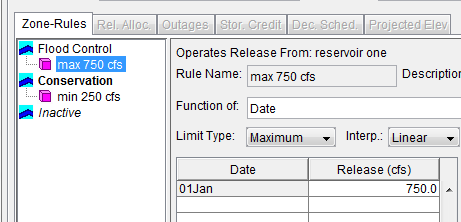If the pool elevation is below the guide curve (set as top of conservation in the model), ResSim will hold as much inflow as possible to rise up to the guide curve as quickly as possible.
If the pool elevation is above the guide curve, ResSim will release as much as needed to get down to top of conservation as quickly as possible.
If there are no rules of operation, its only limitation will be the amount of inflow and the physical capacity of the outlets. To illustrate this, I have developed a simple model with one reservoir.
The first simulation starts with the pool in the conservation zone (note that top of conservation is at elevation 50 ft). The reservoir is holding all of the inflow, and it rises back to top of conservation in just under 2 days (flat pool for first three days in the lookback period). The release is set to 500 cfs in the lookback period which is equal to the inflow. Once the simulation begins, the release drops to zero since there are no requirements.
(Note: pool elevation and outflow are given by the green lines)
With the pool in the conservation zone, ResSim wants to hold as much inflow as possible. This means that the only impact to the result above will be caused by a minimum release requirement. A maximum release requirement would have no impact on this result.
In the next simulation, a minimum release rule of 250 cfs was added in the conservation pool.
In these results, you can see that the rising pool elevation still occurs; however, the amount of time it takes to rise to the top of conservation increases from about 2 days to about 4 days. In the release plot, you can see the release drops to 250 cfs instead of dropping to 0 cfs. Once it reaches top of conservation, it passes inflow (500 cfs) to hold that level.
Next, we can look at how ResSim behaves when the pool is above top of conservation. To do this, I start the simulation with the pool at 52 ft (2 feet into the flood pool). At this point, I have no rules of operation in the flood pool. The pool is drawn down to the top of conservation in about 2 days. The release is set to 1,000 cfs (physical capacity of outlet) once the simulation begins. Recall that the first three days are the lookback period where a constant elevation was specified.
Since ResSim is trying to release as much as possible to get down to top of conservation, a minimum release rule in the flood pool will not affect this result. In the next simulation, a maximum release rule of 750 cfs was developed for the flood pool.
This rule causes the dam to restrict its outflow capacity below the physical capacity of its outlet. As expected, the drawdown to top of conservation is extended due to the reduction in release from 1000 cfs to 750 cfs.











Hello, im currently studying the ResSim software aswell as the reservoir managment topic. I have been looking through the posts from The ResSim Blog and have already found very valuable information. However i would like to know if a post about creating/optimizing a guide curve for a reservoir has been already published, or if it is planned to be published.
ReplyDeleteGiven the guide curve is a fundamental parameter in terms of reservoir operation and I think most of users will be benefited by such a topic.
Thanks & Greetings
Thanks for the question. In ResSim, there is not an automated way of doing this that I know of. Typically, you would do a period of record simulation trying various combinations of guide curves to settle on what you want for a conservation pool and what you want for a flood pool. This type of simulation will give you the sizing of the conservation pool as well as help you determine firm water yield and / or firm power amounts. This will also let you see how your proposed operations handle flood events assuming that you have had some during the period of record. Since period of records, however, are of limited duration, you probably also want to introduce some synthetic events for both drought and flood. This process would be done in an iterative fashion where you take the lessons learned from the previous iterations to inform your next iteration.
Delete